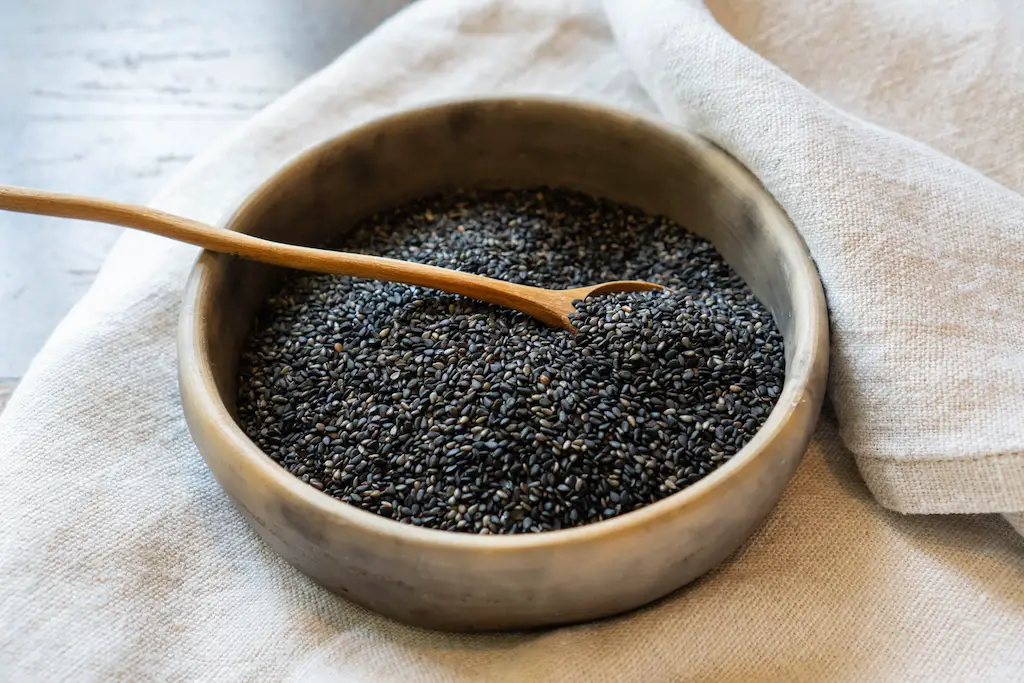This post may contain affiliate links. Please read my disclosure for details at the bottom of this page. As an Amazon Associate, I earn from qualifying purchases on this black sesame seeds post. We hope you enjoy learning about black sesame (known as ‘heukimja’) in Korean cuisine!
Published 04/14/2022 Updated 03/28/2024
Have you ever heard of black sesame seeds? For many countries, such as China, Japan, and South Korea, black sesame seeds are an integral part of the traditional food culture. In this article, I explain how people in South Korea use this ingredient when cooking.
Before I do, to learn more about sesame in Korean cooking, you can read my blog posts about:
- Cham-Kkae (참깨): Raw white sesame seeds
- Chamgireum (참기름): Toasted sesame oil; And
- Toasting Sesame Seeds: How to toast sesame seeds on the stovetop as well as in the microwave and oven.
What Are Black Sesame Seeds?
‘Heukimja’ (흑임자) is the Korean term for the black variety of sesame seeds. Sesame is a flowering plant in the Sesamum genus.
While most wild species of Sesamum are native to sub-Saharan Africa, S. Indicum, the domesticated and cultivated variety, most likely emerged in India. These seeds are one of the oldest known oilseed crops in the world, documented domestication dates back well over 3,000 years. Sesame probably emerged as a crop because of its ability to grow and prosper in areas unsuitable for other crops.
While the most famous type of sesame is creamy and off-white, other sesame varieties come in gold, brown, reddish-brown, black, buff, gray, and even tan. Typically, the color of the hull is the same as the fruit! In this article, we are discussing the black variety!

Black Sesame Seeds in Korean Cooking:
As I stated above, in the Korean language, black sesame seeds are known as ‘heukimja’ (흑임자). Famously, in Japanese and Korean cultures, people grind these seeds into a powder. They then use the powder to coat mochi (Japanese sticky rice cakes) and injeolmi (Korean sweet rice cakes).
Below, we list two other Korean foods that use black sesame seeds:
- Heukimja-Juk (흑임자죽): In English, this is known as black sesame porridge.
- Dasik (다식): Dasik are traditional Korean pressed cookies. Sometimes, these cookies include black sesame seeds.
More recently, people have started to use heukimja to make black sesame milk and black sesame lattes. You can learn how to make both on my blog!
Heukimja Frequently Asked Questions:
Now that we learned about heukimja, I want to answer some questions you may have about this ingredient! If I do not answer your question, feel free to leave a comment in the section below or email me at [email protected].
What Do Black Sesame Seeds Taste Like?
This Korean ingredient has a strong earthy and nutty flavor. Typically, they have a stronger flavor than the creamy white sesame seeds. The white variety, known as ‘cham-kkae’ (참깨) in Korean, is sweeter than the black variety.
Where Can I Buy Black Sesame Seeds?
You can buy these seeds in any well-stocked grocery store. You can also buy them online and at your local Asian market.
When shopping at the store, you can typically find them in two sections. First, you can find them in the spice aisle. Second, you can find them in the Asian section of the international food aisle.
Interestingly, the sesame seeds on the international aisle tend to be way cheaper than those on the spice aisle.
I personally order them online as you can get them in bulk for a much better price!

How Long Does This Ingredient Last?
Generally, raw heukimja seeds last for 1-3 years. Once toasted, they last for 6-12 months when stored in the pantry.
How Should I Store Black Sesame Seeds?
You can store these seeds in an airtight container in the pantry. Make sure to keep them in a cool, dark place when storing them for extended periods.
What Is a Heukimja Substitute?
If you cannot find the black variety of these seeds, you can typically use regular sesame seeds instead. Just note that black sesame seeds taste stronger and are a bit more bitter.
I Hope You Enjoyed Learning About Black Sesame Seeds!
In the end, I hope you enjoyed learning about black sesame seeds (heukimja)! If so, let me know in the comment section!
If you would like to read more about cooking, you can find further recipes on this blog. I listed some of my favorite Carving A Journey recipes below! For reference, many recipes are influenced by my family’s blended Korean and Southern heritage.
Korean Ingredient Articles:
- Soybean Sprouts in Korean Cooking
- Mung Bean Sprouts in Korean Cooking
- Bellflower Root in Korean Cooking (Doraji)
- Enoki Mushrooms in Korean Cooking (Paengi-Beoseot)
Further Carving A Journey Recipes:
- Yakult Soju Cocktail Recipe
- Gochujang Mayo Recipe
- Korean Cabbage Pancakes Recipe (Baechu Jeon)
- Vegetarian Sausage Balls Recipe
- Korean Grits Bowl (Southern-Korean Fusion Dish)
If you have any questions or comments, you can also email me at [email protected]. And, finally, I would love to hear from you through our social media as well! You can follow me at @carvingajourney on Instagram, Facebook, and Pinterest. I also started a vlog YouTube channel with my husband! Or, if you would like more articles like these, you can subscribe to the blog by joining the mailing list. Let me know if you try cooking my heukimja. Thank you so much for stopping by!
Carving A Journey is a participant in the Amazon Services LLC Associates Program, an affiliate advertising program designed to provide a means for sites to earn advertising fees by advertising and linking to Amazon.com. Although we may earn commissions for our endorsement, recommendation, testimonial, and/or link to any products or services from this website, these opinions are my own and I fully support these products.

